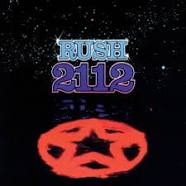20 Rush Albums in 20 Days: 2112
 DAY FOURTEEN: Rush, 2112, running time 38:44, released April 1, 1976
DAY FOURTEEN: Rush, 2112, running time 38:44, released April 1, 1976
Rush decided to go for broke on their fourth album, and the bet paid off. Were it not for the success of 2112, the band would likely have a four-album history, little more than a 70s rock band footnote. It’s hard to believe that the band members were only 22 and 23 years old at the time of the album’s release, and perhaps it’s the ideology and audacity of youth that allowed them to take the risk they did.
The first side of the album, the epic side-long “2112,” still holds up as well as it ever did. What struck me was how simple it is harmonically and rhythmically. Except for a few measures here and there, the entire piece is in 4/4 time, and each section offers simple chord sequences. True, Rush still shows off its chops through its playing, but not yet in its composition (that would begin with the next album, A Farewell to Kings). What distinguishes this effort from other side-long pieces is its relatable story with defining characters, its distinct sections and its variability in dynamics. Unlike, say, Hemispheres, which mostly maintains a full-throttle approach, “2112” allows for room to breathe, from the spaces between notes in “Overture” to the over three minutes from 6:54 to 10:13 when the only instrument to be heard is Alex’s guitar. This is unheard of in Rush’s repertoire in the last thirty years, where less is never deemed enough, opting instead for massive overdubs and unwelcome sound effects that clutter the landscape. Here, we really get to hear the story and relate to the first-person narrator (something “Hemispheres” lacks for the most part) and take a breather between the priests’ outbursts. Geddy Lee expertly alters his voice between the doomed narrator and the all-powerful Priests of Syrinx to help the listener along. It all works so well, though as I’ve noted before, if I’m ever welcomed by a liberator who booms in a deep foreboding voice, “We have assumed control,” I’m going to keep a packed suitcase by the door just in case.
Side two doesn’t hold up as well. “Passage to Bangkok” works beautifully with its infectious opening riff and hummable chorus, but for me “The Twilight Zone” is just so-so, and “Something for Nothing” sounds like it belongs on Caress of Steel with its screeching vocals. “Lessons” and “Tears,” with lyrics by Lifeson and Lee respectively, have some nice parts to be sure and would have been welcome additions on the previous two albums, but here come off sounding a bit week compared to the rest of the album.
2112 presents a band that is still evolving, yet to reach its highest heights, but taking a huge step in the right direction.
Tomorrow, I’ll be listening to…drum roll, please…number 9, Signals, the first Rush tour I ever witnessed. Does the follow-up to Moving Pictures match its predecessor? Stay tuned.



